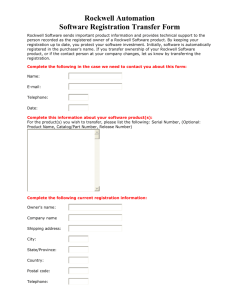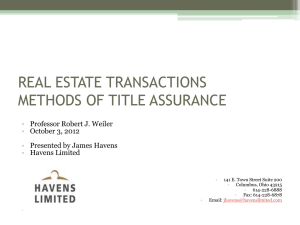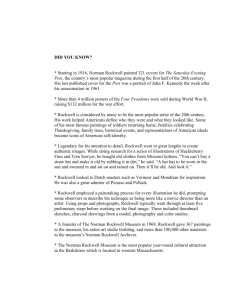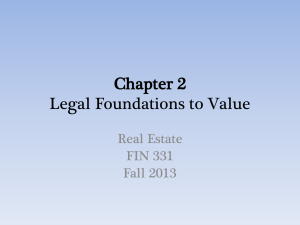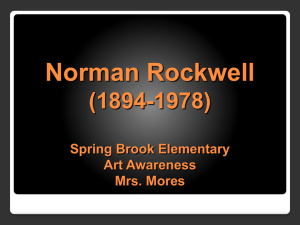Estates
advertisement
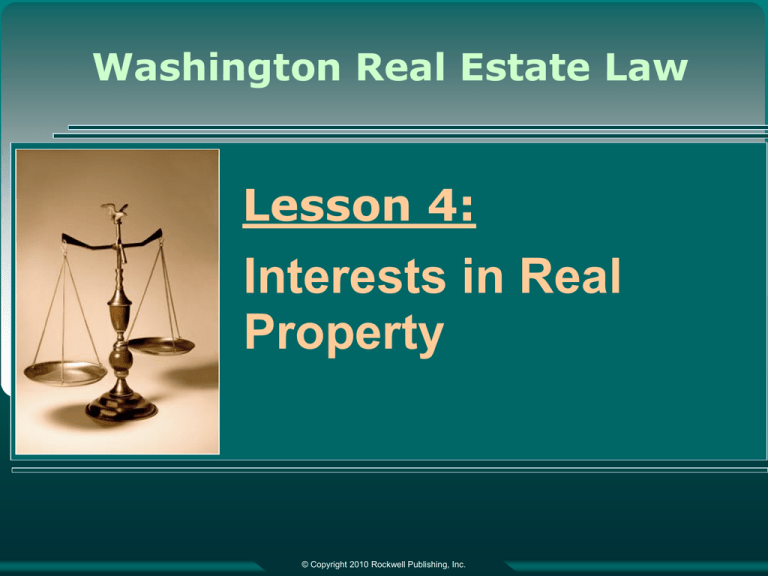
Washington Real Estate Law Lesson 4: Interests in Real Property © Copyright 2010 Rockwell Publishing, Inc. Introduction In this lesson: estates in land (freehold and leasehold), encumbrances, easements, and liens. © Copyright 2010 Rockwell Publishing, Inc. Estates Estate: Interest in land that is (or may become) possessory. Estate may be: freehold, or leasehold. © Copyright 2010 Rockwell Publishing, Inc. Estates Freehold estates Freehold estate: Possessory interest in real property of indefinite duration. Two types of freehold estates: fee simple estate, and life estate. © Copyright 2010 Rockwell Publishing, Inc. Freehold Estates Fee simple Fee simple estate: The most complete type of ownership interest in land. Fee simple estates are: inheritable, transferable, and perpetual. © Copyright 2010 Rockwell Publishing, Inc. Fee Simple Types of fee simple estates There are two types of fee simple estates: fee simple absolute, and fee simple defeasible. © Copyright 2010 Rockwell Publishing, Inc. Types of Fee Simple Estates Fee simple absolute Unless purchase and sale agreement specifies another estate, a fee simple absolute is assumed. The fee simple absolute is the most common type of estate. © Copyright 2010 Rockwell Publishing, Inc. Types of Fee Simple Estates Fee simple defeasible Fee simple defeasible estate: Ownership will terminate if certain event specified in deed occurs (such as failure to use land in particular manner). © Copyright 2010 Rockwell Publishing, Inc. Fee Simple Defeasible Types of fee simple defeasible There are two types of fee simple defeasible estates: fee simple determinable (a.k.a. qualified fee), and fee simple subject to condition subsequent (a.k.a. conditional fee). © Copyright 2010 Rockwell Publishing, Inc. Types of Fee Simple Defeasible Fee simple determinable Fee simple determinable estate: Property will automatically revert back to grantor if certain conditions aren’t met. This estate is created by words such as “so long as” or “until such time as.” © Copyright 2010 Rockwell Publishing, Inc. Types of Fee Simple Defeasible Fee simple determinable Example: Grantor gives land to city “so long as it is used for school purposes.” Eventually city no longer needs the land for a school. Property automatically reverts back to grantor or her heirs. © Copyright 2010 Rockwell Publishing, Inc. Types of Fee Simple Defeasible Subject to condition subsequent Fee simple subject to condition subsequent: Estate may revert back to the grantor if certain conditions aren’t met. Unlike determinable estate, grantor or her heirs must take legal steps to recover property if condition isn’t met—reversion doesn’t occur automatically. © Copyright 2010 Rockwell Publishing, Inc. Freehold Estates Life estate Life estate: An estate owned for the length of someone’s lifetime. Example: Ken dies, leaving land to charity, but grants life estate in land to his sister. Sister may live on land for the rest of her life. On her death, land automatically passes to the charity. © Copyright 2010 Rockwell Publishing, Inc. Life Estates Future possessory interest Future possessory interest: The interest held by the person who gets the property when the life estate ends. There are two types of future possessory interests: estates in remainder, and estates in reversion. © Copyright 2010 Rockwell Publishing, Inc. Future Possessory Interest Estate in remainder Estate in remainder: A future interest held by someone other than the grantor of the life estate. Example: George leaves his second wife, Wilma, a life estate in the family home, with the remainder interest to his children from his first marriage. Wilma can use and possess the property for the rest of her life. On her death, the property will pass automatically to the children, who are known as remaindermen. © Copyright 2010 Rockwell Publishing, Inc. Future Possessory Interest Estate in reversion Estate in reversion: A future interest held by the grantor of the life estate. © Copyright 2010 Rockwell Publishing, Inc. Future Possessory Interest Waste Waste: The destruction or damage of property by a life tenant. Life tenants are prohibited from committing waste. (Those with future possessory interests are entitled to receive the property in reasonable condition.) © Copyright 2010 Rockwell Publishing, Inc. Life Estates Trusts Trusts provide the same benefits as life estates, with the additional safety of a trustee who looks out for the interests of the parties. Thus, life estates are rarely used these days. © Copyright 2010 Rockwell Publishing, Inc. Life Estates Trusts When trust is used like a life estate, trustee holds title to property for the life of beneficiary. When beneficiary dies, property passes to whoever grantor has named in the trust. © Copyright 2010 Rockwell Publishing, Inc. Estates Leasehold estates A leasehold estate is a more limited interest in property than freehold estate. The holder of the leasehold (the tenant) doesn’t own the property, just has exclusive right of possession for a time. © Copyright 2010 Rockwell Publishing, Inc. Leasehold Estates Types of leasehold estates There are three types of leasehold estates in Washington: tenancy for a specific term (a.k.a. estate for years or term tenancy), periodic tenancy, and tenancy at will. © Copyright 2010 Rockwell Publishing, Inc. Types of Leasehold Estates Estate for years The estate for years lasts for a fixed term, specified by a start and end date. Despite name, term may be for any length of time—three months or two years. © Copyright 2010 Rockwell Publishing, Inc. Types of Leasehold Estates Estate for years Example: Ramon is a college student renting an apartment for one semester. The lease gives him the right to possess the apartment from August 20 until December 31. Ramon’s tenancy is an estate for years because it is for a specific time period. © Copyright 2010 Rockwell Publishing, Inc. Types of Leasehold Estates Estate for years An estate for years lease terminates automatically at the end of the specified rental period. The parties may agree to terminate the lease sooner (called surrender). Tenant with an estate for years may assign or sublease his interest unless lease prohibits it. © Copyright 2010 Rockwell Publishing, Inc. Types of Leasehold Estates Periodic tenancy A periodic tenancy continues from period to period, and renews itself indefinitely. Tenancy ends only when landlord or tenant gives notice of termination. Most periodic tenancies are month-to-month. © Copyright 2010 Rockwell Publishing, Inc. Types of Leasehold Estates Periodic tenancy In Washington, a periodic tenancy may be terminated by written notice from either party (landlord or tenant) 30 days or more before the end of the rental period. However, if the tenancy is covered by the Residential Landlord-Tenant Act (RLTA), it may be terminated by written notice from either party 20 days or more before the end of the rental period. © Copyright 2010 Rockwell Publishing, Inc. Types of Leasehold Estates Tenancy at will A tenant at will possesses property with the permission (or at the will) of the owner. A tenancy at will has no specified termination date and no periodic time limits. Usually no rent is paid, or else rent is nonmonetary (such as manual labor). © Copyright 2010 Rockwell Publishing, Inc. Types of Leasehold Estates Tenancy at sufferance Tenancy at sufferance occurs when tenant started out with a valid lease, but then remains on premises without landlord’s consent when lease expires. Tenancy at sufferance isn’t really an estate, because tenant has no right of possession. © Copyright 2010 Rockwell Publishing, Inc. Types of Leasehold Estates Tenancy at sufferance Because tenant (called a holdover tenant) has no possessory interest in the property, landlord doesn’t have to give him notice of termination. To remove tenant, landlord must follow proper eviction procedures. © Copyright 2010 Rockwell Publishing, Inc. Summary Estates Freehold estate Leasehold Fee simple estate Estate for years Fee simple absolute Periodic tenancy Tenancy at will Fee simple defeasible Tenancy at sufferance Life estate Remainderman © Copyright 2010 Rockwell Publishing, Inc. Encumbrances Encumbrance: A nonpossessory interest in real property that encumbers or burdens title. Encumbrances are either financial or nonfinancial. © Copyright 2010 Rockwell Publishing, Inc. Encumbrances Nonfinancial encumbrances: Encumbrances that affect the property’s use or physical condition, such as easements. Financial encumbrances: Encumbrances that affect only the property’s title; they are called liens. © Copyright 2010 Rockwell Publishing, Inc. Nonfinancial Encumbrances Easements Easement: A right to use someone else’s land for a particular purpose. Easements are nonfinancial encumbrances. A homeowner’s title insurance policy should list all easements on property. © Copyright 2010 Rockwell Publishing, Inc. Easements Positive and negative An easement may be either positive or negative. Positive easement authorizes a party to do something on another’s land, and may include right to take something from the land (such as gather fruit). Negative easement prohibits a landowner from doing something on her own land (a.k.a. restrictive covenants). © Copyright 2010 Rockwell Publishing, Inc. Easements Positive and negative Positive easements can be either: appurtenant, or in gross. © Copyright 2010 Rockwell Publishing, Inc. Easements Appurtenant An appurtenant easement benefits a particular piece of land. Dominant tenement is land that receives benefit of easement. Servient tenement is land over which easement runs. © Copyright 2010 Rockwell Publishing, Inc. Easements Appurtenant Example: Albright owns a landlocked piece of property with no access to the road. Albright has a right-of-way easement to travel over Schindler’s neighboring property to reach the road. The Schindler property is the servient tenement because the easement runs across it. The Albright property is the dominant tenement because it benefits from the easement. © Copyright 2010 Rockwell Publishing, Inc. Easements Appurtenant An appurtenant easement runs with the land. If the land is transferred (sold, inherited, or gifted), easement goes with it. © Copyright 2010 Rockwell Publishing, Inc. Easements In gross Easement in gross: A right of use that belongs to an individual or commercial entity rather than being appurtenant to a piece of land. There is no dominant tenement, only a servient tenement across which the easement runs. A personal easement in gross cannot be sold or assigned. If easement holder dies, easement terminates. © Copyright 2010 Rockwell Publishing, Inc. Easements In gross Most easements in gross are commercial rather than personal. Commercial easements in gross are freely assignable and transferable. © Copyright 2010 Rockwell Publishing, Inc. Easements Creating easements Easements can be created by: express grant or reservation, plat maps, implication from prior use or necessity, estoppel, or prescription. © Copyright 2010 Rockwell Publishing, Inc. Creating Easements Express easements Express easement: An easement created via a deed or other legal document. Example: David sells the west half of his property to Martha. In the deed, he expressly grants Martha the right to use the private road located on his half of the property. © Copyright 2010 Rockwell Publishing, Inc. Creating Easements Plat maps Plat map easement: Express easement created by recording a plat map. If a landowner subdivides and sells land according to a recorded plat, the purchasers acquire easements to use the roads, alleys, and all common areas shown on the plat. © Copyright 2010 Rockwell Publishing, Inc. Creating Easements Implication Implied easement: Easement found to exist because circumstances suggest the parties meant easement to be created. Arises only when tract of land was originally under common ownership (owned by the same individual) and then was divided into two or more parcels. © Copyright 2010 Rockwell Publishing, Inc. Creating Easements Implication The existence of these easements may be implied by either: prior use, or obvious necessity. © Copyright 2010 Rockwell Publishing, Inc. Creating Easements Implication For easement to be implied from prior use, the use must be: long-term, readily apparent from visual inspection of the property at time of sale, and reasonably necessary for enjoyment of the dominant tenement. © Copyright 2010 Rockwell Publishing, Inc. Creating Easements Implication If easement is essential to a parcel of property, a court may find an easement by necessity even if there is no apparent prior use. Example: If a lot is completely landlocked with no access to roads, and no express easement has been given, an easement by necessity may be found to provide access to the road. © Copyright 2010 Rockwell Publishing, Inc. Creating Easements Estoppel Easements can also be created by estoppel—a person acts in a way that suggests an easement exists and so that person can’t later deny that the easement exists. © Copyright 2010 Rockwell Publishing, Inc. Creating Easements Prescription Easement by prescription: An easement created by someone making long and continuous use of another’s property without permission. © Copyright 2010 Rockwell Publishing, Inc. Creating Easements Prescription To acquire easement by prescription, use of easement must be open and notorious. This means use must be clearly visible to landowner if she visited the property. © Copyright 2010 Rockwell Publishing, Inc. Creating Easements Prescription Use must also be hostile or adverse, meaning without permission of owner. If owner knows of use and does not object—but also does not give permission—use is hostile. If owner gives consent, a license has been granted, and an easement by prescription cannot develop. © Copyright 2010 Rockwell Publishing, Inc. Creating Easements Prescription In Washington, use must be continuous and uninterrupted for ten years. Continuous does not mean constant, but only a continuous use that is normal for that property. Note: There can be no prescriptive easements against government property. © Copyright 2010 Rockwell Publishing, Inc. Easements Maintenance and repair Neither party has duty to maintain or repair easement unless that duty is stated in the easement grant or a maintenance agreement. © Copyright 2010 Rockwell Publishing, Inc. Easements Termination Easements may terminate by various means: 1. express agreement (document may be called a release), 2. automatic termination (if grant creating easement specifies an end date), 3. condemnation (taken by government for public use on payment of just compensation), © Copyright 2010 Rockwell Publishing, Inc. Easements Termination 4. implied termination (implied by actions of parties or circumstances beyond the parties’ control), 5. merger (when easement owner also becomes owner of property subject to the easement), 6. end of necessity, © Copyright 2010 Rockwell Publishing, Inc. Easements Termination 7. abandonment (must be shown by clear act showing owner’s intent—nonuse alone not enough), 8. failure of purpose (easements created for a particular purpose terminate when the purpose is met), 9. destruction of servient tenement (when easement exists in a building and building is destroyed), © Copyright 2010 Rockwell Publishing, Inc. Easements Termination 10. estoppel (conduct of easement holder makes servient property owner believe that easement won’t be used, and owner spends money or other resources on this assumption), and 11. prescription (acts by owner of servient property that interfere with easement’s use; prescriptive use must be open, continuous, and uninterrupted for ten years). © Copyright 2010 Rockwell Publishing, Inc. Easements Compared to licenses Easement is not license. License: Permission to enter another’s property for a specific purpose. Does not create an interest in the property. © Copyright 2010 Rockwell Publishing, Inc. Easements Compared to licenses Easements often for indefinite period; licenses usually more temporary. Easements can’t be revoked; licenses can. © Copyright 2010 Rockwell Publishing, Inc. Easements Compared to licenses Easements usually created by written agreement or action of law; licenses often created by verbal agreement. License is personal right; can’t be sold or otherwise transferred, and expires if licensee dies. © Copyright 2010 Rockwell Publishing, Inc. Encroachment/Trespass/Nuisance Three common sources of neighbor disputes: encroachment, trespass, and nuisance. © Copyright 2010 Rockwell Publishing, Inc. Encroachment/Trespass/Nuisance Encroachment Encroachment: A structure or object that extends over property line into neighbor’s land (fence, garage, shed, etc.). © Copyright 2010 Rockwell Publishing, Inc. Encroachment/Trespass/Nuisance Encroachment Most encroachments are unintentional, resulting from mistake concerning exact location of property line. A court can order encroachment removed. If removal cost is too high, court can order encroacher to pay damages. © Copyright 2010 Rockwell Publishing, Inc. Encroachment/Trespass/Nuisance Trespass Trespass: Entry onto another’s land without permission or legal authority, violating landowner’s right to exclusive possession. Hunting on someone’s property without permission is example of trespass. In the case of leased property, trespass violates tenant’s right to exclusive possession. © Copyright 2010 Rockwell Publishing, Inc. Encroachment/Trespass/Nuisance Trespass Trespass is a tort—an injury against a person or property, though trespass may also be a criminal act. Trespass includes invading property with a substance or object (such as parking a car in someone’s driveway without permission). © Copyright 2010 Rockwell Publishing, Inc. Encroachment/Trespass/Nuisance Nuisance Nuisance: Any activity that substantially interferes with an owner’s use and enjoyment of property, or with the general welfare of the community. © Copyright 2010 Rockwell Publishing, Inc. Encroachment/Trespass/Nuisance Nuisance Public nuisance: A nuisance that affects entire community or neighborhood. Private nuisance: A nuisance that affects only one person or just a few people. Court can issue injunction to stop nuisance. © Copyright 2010 Rockwell Publishing, Inc. Summary Easements Encumbrances License Easement Encroachment Appurtenant Trespass Dominant tenement Nuisance Servient tenement © Copyright 2010 Rockwell Publishing, Inc. Liens A lien is a financial encumbrance on property that gives a creditor the right to have a debt paid out of the debtor’s property if the debtor fails to pay. Lienholder does not own or possess the property, but could cause property to be sold to satisfy lien. © Copyright 2010 Rockwell Publishing, Inc. Liens Liens against property don’t prevent its sale or other transfer, but new owner takes property subject to the liens. © Copyright 2010 Rockwell Publishing, Inc. Liens Classification Voluntary liens: Liens owner places against his own property, usually to secure repayment of a debt (like mortgage or deed of trust). Involuntary liens: Liens that arise through operation of law, without requiring property owner’s consent (like property tax liens). © Copyright 2010 Rockwell Publishing, Inc. Liens Classification General lien: Attaches to all debtor’s property. Specific lien: Attaches only to particular piece of property (a deed of trust attaches only to the property offered as security for the loan). © Copyright 2010 Rockwell Publishing, Inc. Liens Real estate liens Some common types of liens against real estate: mortgages and deeds of trust, construction liens, judgment liens, and tax liens. © Copyright 2010 Rockwell Publishing, Inc. Real Estate Liens Mortgages and deeds of trust Mortgages and deeds of trust are placed by borrower on a piece of his property to secure a loan. These liens are voluntary and specific. © Copyright 2010 Rockwell Publishing, Inc. Real Estate Liens Construction liens Construction liens are filed by suppliers of materials or labor against a property to secure payment for the materials or labor. These liens are involuntary and specific. © Copyright 2010 Rockwell Publishing, Inc. Construction Liens Filing A construction lien is created by filing notice of the claim at the recorder’s office in county where property is located. Laborer or supplier can waive right to file a construction lien, but waiver must be clearly stated in the contract. © Copyright 2010 Rockwell Publishing, Inc. Construction Liens Notice Strict notice rules: Laborers and suppliers must give general contractor and property owner a written preclaim notice of right to claim a lien. Pre-claim notice must be served personally or by certified or registered mail. © Copyright 2010 Rockwell Publishing, Inc. Construction Liens Claim Lien claim must be filed within 90 days after last performing work or furnishing materials for the project. Lien filed more than 90 days after labor or materials were last furnished is invalid. © Copyright 2010 Rockwell Publishing, Inc. Construction Liens Foreclosure Construction liens must be foreclosed judicially (through court system). Foreclosure action must be brought within eight months after lien was recorded, in the county where the real estate is located. © Copyright 2010 Rockwell Publishing, Inc. Construction Liens Termination Property owner terminates construction lien by paying the debt underlying the lien. In Washington, owner may also release a construction lien by giving a bond or paying the amount owed into court to cover a potentially valid claim. © Copyright 2010 Rockwell Publishing, Inc. Liens Judgment liens Judgment liens arise from a court ruling that one party owes money to another. The court enters a judgment, and winner (judgment creditor) obtains a judgment lien against property owned by loser (judgment debtor). This type of lien is involuntary and general. © Copyright 2010 Rockwell Publishing, Inc. Judgment Liens Attachment Judgment lien automatically attaches to all of debtor’s property in the county where the judgment was entered, except to the debtor’s principal residence (homestead). Lien will attach to homestead property if the judgment creditor records an abstract of judgment with the county recorder. © Copyright 2010 Rockwell Publishing, Inc. Judgment Liens Attachment If debtor owns property in other counties, judgment creditor may file abstract of judgment in other counties and attach the additional properties. © Copyright 2010 Rockwell Publishing, Inc. Judgment Liens Attachment Judgment lien also attaches to any property acquired by the debtor during the lien period. Example: Glen owns two acres of land in Snohomish County. He loses a lawsuit and a judgment is entered against him. The winner obtains a lien against Glen’s property for the judgment amount. Two months later, Glen’s father dies, leaving Glen property in Snohomish County. The judgment lien also attaches to this property. © Copyright 2010 Rockwell Publishing, Inc. Judgment Liens Attachment Once a judgment lien has attached to property, the debtor must pay the judgment to free the property from the lien. If judgment not paid, property can be sold to satisfy the debt. © Copyright 2010 Rockwell Publishing, Inc. Judgment Liens Termination Judgment lien can be terminated by paying the amount owed. Judgment liens also terminate according to statutory limitations. In Washington, a judgment lien is generally valid for ten years, although lienholder may seek a ten-year extension. © Copyright 2010 Rockwell Publishing, Inc. Liens Tax liens Tax liens are placed against real property to secure payment of annual property taxes, special assessments, income taxes, etc. Real property is assessed (appraised) and then taxed according to its value. Liens for property taxes are involuntary and specific. © Copyright 2010 Rockwell Publishing, Inc. Tax Liens Special assessments Special assessments are taxes levied by municipalities to pay for local improvements (such sewer lines). Special assessments are levied only against those properties that actually benefit from the improvement. An unpaid special assessment becomes an involuntary, specific lien against the property. © Copyright 2010 Rockwell Publishing, Inc. Tax Liens Income taxes Unpaid federal income taxes give rise to a lien. Income tax liens are involuntary and general. Liens apply to all property owned by the taxpayer, both personal and real. © Copyright 2010 Rockwell Publishing, Inc. Liens Lien priority A piece of property may have several types of liens against it (mortgage, construction lien, tax lien, etc.). Liens may total more than the property is worth, meaning all the liens won’t be paid in full. © Copyright 2010 Rockwell Publishing, Inc. Liens Lien priority Liens are not paid on a pro rata basis. Liens are usually paid in the order they were recorded. The lien recorded first is paid first. © Copyright 2010 Rockwell Publishing, Inc. Liens Lien priority Exceptions to the first to record rule: Property tax liens and special assessment liens are superior to all other liens against the property. They have first priority, even if another lien was recorded first. Construction lien priority is based on date work or materials are first provided. © Copyright 2010 Rockwell Publishing, Inc. Liens Protecting the debtor When a creditor forecloses a lien, money from the foreclosure sale may not cover the amount owed. To recover the remainder, creditor may get a deficiency judgment—a court order requiring the debtor to pay the creditor the remaining amount. © Copyright 2010 Rockwell Publishing, Inc. Liens Protecting the debtor Limits on the right to obtain deficiency judgments: No deficiency judgment is available after a trustee’s sale under deed of trust. © Copyright 2010 Rockwell Publishing, Inc. Liens Protecting the debtor Homestead law: A state law that can help protect family residences from foreclosure of some types of liens. © Copyright 2010 Rockwell Publishing, Inc. Liens Protecting the debtor Washington law provides automatic homestead exemption for property used as a principal residence: A homestead is exempt from foreclosure of judgment liens for up to the value of the property or $125,000, whichever is less. © Copyright 2010 Rockwell Publishing, Inc. Liens Protecting the debtor Use of the homestead exemption is fairly rare, because it doesn’t offer protection against: mortgages or deeds of trust, construction liens, tax liens, child support or spousal maintenance obligations, or condo or homeowners association liens. © Copyright 2010 Rockwell Publishing, Inc. Summary Liens Specific lien General lien Construction lien Foreclosure Priority Judgment lien Special assessment Homestead exemption © Copyright 2010 Rockwell Publishing, Inc.

